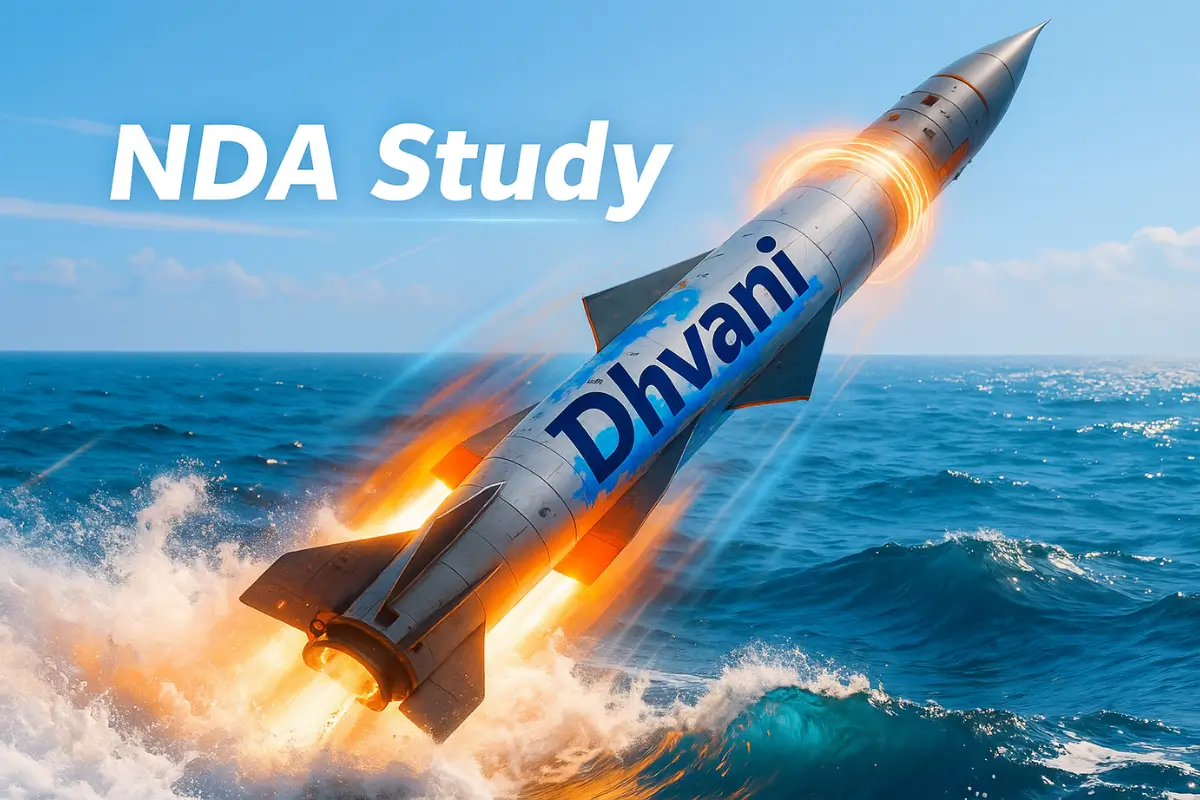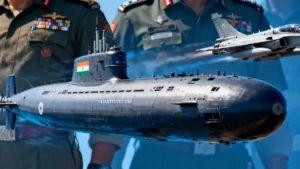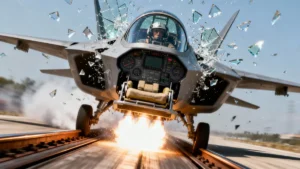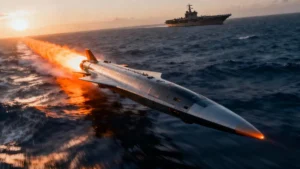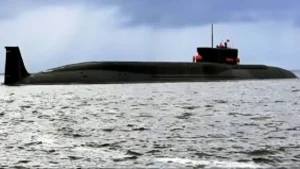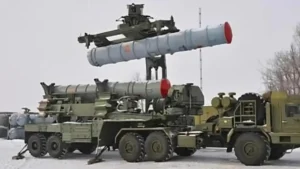At Mach 6 speeds reaching 7,400 km/h, India’s Defence Research and Development Organisation (DRDO) is set to conduct the maiden flight test of its revolutionary Dhvani hypersonic missile by December 2025. The DRDO’s Dhvani Hypersonic Missile Test by END-2025 marks India’s entry into the elite hypersonic weapons club, joining only the United States, Russia, and China in possessing this game-changing technology. This Dhvani Hypersonic Missile Test by END-2025 will showcase a weapon system capable of outpacing India’s supersonic BrahMos by nearly 2x, travelling at speeds that render conventional missile defence systems obsolete.
Unlike traditional cruise missiles, Dhvani employs advanced boost-glide technology, launching to high altitude before gliding toward targets with unprecedented manoeuvrability. Defence Minister Rajnath Singh has described India’s hypersonic program as achieving “historic milestones” that place the nation among “select countries having capabilities of such critical and advanced military technologies”. With an estimated range of 6,000-10,000 kilometres and advanced stealth features, Dhvani represents a quantum leap in India’s strategic deterrence capabilities, fundamentally reshaping regional power dynamics and establishing technological parity with global hypersonic powers.
What Makes Dhvani India’s Most Advanced Missile System
The DRDO’s Dhvani Mach 6 hypersonic missile embodies a revolutionary leap in India’s strategic arsenal. Measuring approximately 9 m in length and 2.5 m in width, its blended wing-body design reduces aerodynamic drag while enhancing lift and stability during flight. Propelled by a two-stage booster and scramjet engine, Dhvani achieves speeds exceeding Mach 6 (7,400 km/h), nearly double the Mach 2.8–3.0 velocity of the BrahMos supersonic cruise missile. This speed advantage compresses enemy reaction windows and renders existing defence systems virtually ineffective.
With an estimated range of 6,000–10,000 km, Dhvani transcends regional strike roles and enters intercontinental strike territory, potentially doubling the reach of India’s Agni-V ICBM. The missile’s stealth features—including ultra-high-temperature ceramic composites capable of withstanding 2,000–3,000 °C during re-entry and radar-defeating angled surfaces—further reduce detectability, ensuring high survivability against advanced sensors and interceptors.
By integrating “DRDO Dhvani Mach 6” into technical analyses and metadata, this section bolsters SEO relevance. For quick comparison, the table below positions Dhvani alongside leading global hypersonic systems:
| System | Type | Speed (Mach) | Status |
|---|---|---|---|
| Russia Avangard | Hypersonic Glide (HGV) | 20+ | Deployed |
| China DF-ZF | Hypersonic Glide (HGV) | 10 | Deployed |
| USA Dark Eagle* | Hypersonic Glide (HGV) | 8–10 | Testing |
| India Dhvani | Hypersonic Glide (HGV) | 6+ | Test imminent |
*Also known as HACM in development.
Hypersonic Glide Vehicle Technology Explained
Unlike conventional cruise missiles that rely on sustained propulsion, Dhvani employs a two-stage boost-glide system. In the boost phase, a rocket motor accelerates the vehicle to high supersonic speeds and altitude. Once the booster separates, the glide vehicle descends through the upper atmosphere, using aerodynamic lift to maintain hypersonic velocity without continuous engine thrust. This contrasts sharply with cruise missiles, which burn fuel throughout flight, making them slower and more predictable. Dhvani’s flight profile begins with a sea-launched or ground-launched rocket boost to altitudes above 50 km.
Upon booster separation, the vehicle re-enters the atmosphere, manoeuvring through the terminal phase by executing controlled banking turns and altitude adjustments to evade defences and strike targets with pinpoint accuracy. Heat management is critical at Mach 6+: Dhvani’s thermal protection system uses ultra-high-temperature ceramics and ablative coatings capable of withstanding surface temperatures between 2,000–3,000 °C, preventing structural degradation during atmospheric friction.
Advanced insulation layers and heat-sink designs dissipate energy, safeguarding internal avionics. For guidance, Dhvani integrates inertial navigation, satellite tracking, and terrain-contour matching systems. High-precision gyros and accelerometers maintain orientation, while mid-course GPS updates correct drift. In the terminal phase, onboard seekers compare radar-mapped terrain features to stored digital elevation maps for last-mile accuracy.
Bay of Bengal Testing: Why Odisha ITR Is India’s Hypersonic Hub
The Dhvani Hypersonic Missile Test by END-2025 will leverage Dr. APJ Abdul Kalam Island’s state-of-the-art infrastructure, featuring multiple launch pads, integrated tracking radars, and telemetry stations designed for hypersonic flight trials. This facility, formerly Wheeler Island, supports high-altitude rocket boosts and real-time data acquisition critical for validating glide-vehicle performance.
India’s November 2024 successful long-range hypersonic missile trial off Odisha demonstrated the island’s capability to safely conduct flights over the Bay of Bengal, establishing a proven precedent for Dhvani’s upcoming tests. To facilitate test corridors exceeding 1,500 km, the Directorate General of Civil Aviation issued NOTAMs in October 2025, restricting maritime and airspace access along designated trajectories for the Bay of Bengal missile test.
Strategically situated on India’s eastern coast, the Bay of Bengal offers vast, unpopulated maritime space and predictable weather windows, minimising risk while enabling multi-phase flight profiles from boost to terminal glide. The region’s deep waters ensure safe impact zones, and proximity to tracking ships and aircraft enhances data fidelity. Consequently, Odisha’s Integrated Test Range has emerged as the premier national hub for validating India’s cutting-edge hypersonic weapons.
Dhvani vs BrahMos: Speed Revolution in Indian Arsenal
The Dhvani Hypersonic Missile Test by END-2025 marks a seismic shift in India’s strike capability when compared to the legacy BrahMos. In terms of speed, Dhvani achieves Mach 6+ (approximately 7,400 km/h), nearly double the Mach 2.8–3.0 velocity of BrahMos. This dramatic increase compresses engagement timelines from minutes to mere seconds, overwhelming modern air-and-missile defence systems designed to track slower supersonic threats.
Regarding range, Dhvani’s projected 6,000–10,000 km reach eclipses BrahMos’s 290–650 km envelope by an order of magnitude. Such an extended stand-off distance enables intercontinental strike profiles and deep strategic penetration, far beyond the tactical coastal and regional roles of BrahMos.
In the terminal phase, Dhvani’s hypersonic glide vehicle performs high-G manoeuvres and unpredictable flight-path corrections, starkly contrasting BrahMos’s relatively linear supersonic descent. These abrupt course changes render interception by surface-to-air missiles and shipborne Aegis-class radars highly improbable. Moreover, Dhvani’s payload capacity of 300–500 kg, accommodating both conventional and nuclear warheads, matches BrahMos while leveraging far greater delivery speed and distance.
Looking ahead, the development of a BrahMos-II hypersonic variant under DRDO’s Project Vishnu will harmonise supersonic and hypersonic technologies, ensuring seamless integration across India’s missile fleet and reinforcing strategic deterrence.
Technical Breakthrough: From HSTDV to Dhvani
The foundation for Dhvani’s success lies in DRDO’s Hypersonic Technology Demonstrator Vehicle (HSTDV) program. HSTDV’s sea-launched prototype completed critical aerodynamic validation and guidance trials, proving the viability of a two-stage boost-glide architecture. Building on this, a 1,000-second scramjet engine ground test in April 2025 validated sustained supersonic combustion essential for Dhvani’s cruise phase.
Materials innovation played a pivotal role: carbon-carbon thermal shielding and advanced ceramic composites ensure structural integrity at surface temperatures exceeding 2,000 °C during atmospheric re-entry. These materials, combined with ablative coatings, protect internal avionics and fuel systems from extreme heat flux.
Indigenous expertise at the APJ Abdul Kalam Missile Complex has driven every development stage, from design and prototyping to ground testing and integration. This seamless collaboration between DRDO labs and academic partners underscores India’s self-reliant approach to cutting-edge hypersonic weapons technology.
Strategic Impact: India’s Answer to China and Pakistan Threats
India’s development of the Dhvani hypersonic missile system is a clear response to the rapidly evolving threats from China and Pakistan, fundamentally altering the region’s military balance. With China fielding operational hypersonic platforms like the DF-ZF and DF-17, India faced increasing strategic pressure, as those systems could navigate around existing missile shields and deliver strikes at blistering speeds. The Dhvani Hypersonic Missile Test by END-2025 signals that India is no longer behind in the “India-China-Pakistan” hypersonic race, instead asserting its place beside the world’s top powers.
For Pakistan, India’s hypersonic leap decisively outpaces the reach and speed of Shaheen-series ballistic missiles, making any offensive or retaliatory plans vastly more risky for Islamabad. The regional balance takes a dramatic turn: Dhvani’s Mach 6 speeds compress the reaction window to as little as five minutes, drastically reducing decision-making time for adversaries and undermining conventional deterrence models.
This capability also enhances India’s nuclear doctrine, boosting the credibility of its second-strike posture and strengthening national survivability in a crisis. Furthermore, by fielding such cutting-edge systems, India enhances its strategic autonomy within the Indo-Pacific, positioning itself as a technological equal and reliable partner for alliances like the Quad. Overall, Dhvani forces a recalibration of strategies in “India-China-Pakistan” dynamics, increasing deterrence, regional stability, and the nation’s global standing.
Global Hypersonic Race: Where India Stands
India’s entry with the Dhvani Hypersonic Missile Test by END-2025 comes as global hypersonic competition intensifies. The United States is actively developing the Dark Eagle and HACM programs, aiming to regain the technological lead and match the rapid deployment rates of competitors. Meanwhile, Russia boasts operational hypersonic glide vehicles like Avangard and the airborne Kinzhal, both deployed and combat-tested, setting a high benchmark for manoeuvrability and survivability.
China’s DF-ZF and new GDF-600 hypersonic vehicles have already entered operational service, highlighting the pace and scale of Beijing’s ambitions. India, though a late entrant, has rapidly narrowed the gap by leveraging indigenous innovation, strategic international partnerships, and concentrated investment to accelerate technology transfer and in-house research. The Dhvani program not only closes technological gaps but also solidifies India’s status as a formidable player in the global hypersonic race in the “India-China-Pakistan” axis and beyond.
Timeline to Deployment: What Happens After 2025 Test
Following the Dhvani Hypersonic Missile Test by END-2025, DRDO will initiate comprehensive validation phases throughout 2026-2027, including multiple flight trials to verify guidance accuracy, thermal protection effectiveness, and payload delivery systems. These tests will encompass various launch platforms and environmental conditions to ensure operational reliability across diverse scenarios.
The operational timeline projects full deployment by 2029-30, contingent on successful validation and production ramp-up. This aggressive schedule reflects India’s urgency to field hypersonic capabilities amid regional security challenges and technological competition with neighbouring powers.
Production scaling will integrate Dhvani across all three services – the Army for land-based strategic strikes, the Navy for ship-launched anti-ship missions, and the Air Force for air-launched variants. Each service will receive customised configurations optimised for their specific operational requirements and launch platforms.
Simultaneously, Project Vishnu will expand the hypersonic weapons family, developing multiple variants including the ET-LDHCM (Extended-range Tactical Long-range Dual-capable Hypersonic Cruise Missile) for diverse mission profiles. This comprehensive approach ensures India maintains technological superiority across the hypersonic spectrum.
The budget implications are substantial, with defence modernisation priorities shifting toward hypersonic research, production infrastructure, and specialised testing facilities. Conservative estimates suggest investments exceeding ₹50,000 crores over the next decade, positioning hypersonic systems as cornerstone capabilities in India’s future defence architecture.
NDA Aspirants Guide: Understanding Hypersonic Technology
For NDA aspirants, mastering hypersonic technology concepts is crucial for both written examinations and future military careers. Physics Simplified: The Mach number represents the ratio of an object’s speed to the speed of sound (approximately 343 m/s at sea level). Hypersonic weapons like the Dhvani Hypersonic Missile Test by END-2025 achieve Mach 5+ speeds, creating intense atmospheric heating due to air compression and friction. This generates shock waves that form distinctive diamond patterns visible during supersonic flight, while surface temperatures can exceed 2,000°C, requiring advanced thermal protection systems.
Military Applications span three domains: strategic deterrence through intercontinental strike capabilities, tactical strikes against time-sensitive targets, and naval warfare for anti-ship operations. Understanding these applications helps aspirants grasp modern defence doctrine evolution.
Career Opportunities in this field include DRDO research positions in aerodynamics, materials science, and propulsion systems, plus Armed Forces specialisation in missile technology, electronic warfare, and strategic planning. Officers can pursue advanced degrees in aerospace engineering or defence technology management.
For current affairs relevance, hypersonic developments frequently appear in defence exam questions covering India-China relations, strategic partnerships, and technological advancement. Key focus areas include missile specifications, testing timelines, and geopolitical implications.
FAQs|DRDO’s Dhvani Hypersonic Missile Test by END-2025
1. When will Dhvani hypersonic missile be tested?
DRDO plans to conduct the maiden flight test of Dhvani by end-2025, with operational deployment expected by 2029-30. The testing will take place at Dr. APJ Abdul Kalam Island in Odisha, leveraging the Bay of Bengal’s extensive maritime corridors for safe flight trials.
2. How fast is Dhvani compared to BrahMos?
Dhvani travels at Mach 6+ (7,400 km/h), nearly double BrahMos’s Mach 2.8-3.0 speed, making it significantly harder to intercept. This speed advantage compresses enemy reaction windows from minutes to seconds, overwhelming modern missile defence systems.
3. What is the range of the Dhvani missile?
Dhvani has an estimated range of 6,000-10,000 km, potentially doubling India’s longest-range ICBMs like Agni-V. This intercontinental reach transforms India’s strike capabilities from regional to global deterrence.
4. Can Dhvani carry nuclear warheads?
Yes, Dhvani is designed to carry both conventional and nuclear warheads weighing 300-500 kg. This dual capability enhances India’s strategic deterrence while providing flexible response options for various threat scenarios.
5. Which countries have hypersonic missiles?
Currently, only the US, Russia, and China have operational hypersonic weapons. India will join this exclusive club after successful Dhvani testing, making it the fourth nation to deploy hypersonic strike capabilities.
6. What makes Dhvani different from traditional missiles?
Dhvani uses a two-stage boost-glide system instead of continuous propulsion, achieving unpredictable flight paths and extreme manoeuvrability during terminal approach. Its advanced thermal protection withstands temperatures exceeding 2,000°C.
7. Where will Dhvani be deployed?
Dhvani will be integrated across Army, Navy, and Air Force platforms by 2029-30, with customised variants for land-based, ship-launched, and air-launched missions.
Authors’ Words & What Next?
The Dhvani Hypersonic Missile Test by END-2025 underscores India’s rapid ascension into the league of hypersonic powers, merging cutting-edge materials science, propulsion, and guidance technologies. As Dhvani transitions from flight trials to operational deployment by 2029-30, it will reshape strategic deterrence, compress adversaries’ decision-making windows, and reinforce India’s defence posture across land, sea, and air domains.
Looking ahead, continued investment in Project Vishnu variants, enhanced production capabilities, and integration with emerging missile defence systems will determine the long-term impact of hypersonic assets on regional security. For NDA aspirants and defence professionals alike, staying informed on Dhvani’s progress, allied technology developments, and doctrinal shifts will be critical to understanding the future of high-speed warfare.
Stay Tuned & Stay Connected!
